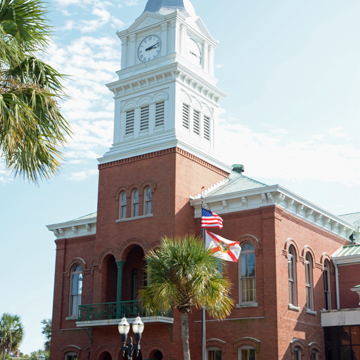Located in northeastern Florida, in an area whose first European settlers were from France, Fernandina formed a critical threshold in the state. After only a few years under the French flag (1562–1565), Amelia Island, where Fernandina was located, became Spanish (1565–1763 and 1783-1821), British (1763–1783), and then United States territory in 1821. The island was named in the eighteenth century after Amelia, the daughter of George II of England, but the settlement had long since been named Fernandina, after the King Ferdinand of Spain. With its deep port and easy access to Georgia to the north and the rest of the Spanish colonial empire to the south, Fernandina became an important town for the import and export of banned cargo. In the early 1800s, this included the import of enslaved persons, who were briefly forbidden from entering the United States from foreign ships.
Almost immediately after it became part of the United States, Fernandina developed into a tourist destination, making its transformation into an “American” resort even more critical. In 1891, when the courthouse was built, Mallory’s New York and Florida steamship line, for example, ran from New York to Fernandina, which it touted as “the largest, most beautiful, and deepest harbor on the coast of Florida.” The popularity of Fernandina changed, of course, when Henry Flagler opened the Ponce de Leon Hotel in St. Augustine, shifting the popular resort destinations further south.
Fernandina had been platted in 1851 by the Florida Railroad company with the railroad depot located at the end of Centre Street. The site for the new Nassau County Courthouse was a lot at the intersection of Centre and Sixth streets in the core of the new city. The courthouse was required to be of brick and contain, in addition to the courthouse functions, space for the county’s Board of Health and the Board of Public Instruction. The county commissioners put the project out to bid but after rejecting several proposals, they selected Ellis and McClure after journeying to see the firm’s recently completed (1889) Clay County Courthouse in nearby Green Cove Springs.
The Nassau and Clay county courthouses share the same entrance portico and iron columns, but little else. At the front entrance to the Nassau County Courthouse, four steps lead up to a tripartite arcade that supports a second arcade above. This ensemble forms the lower two-thirds of the brick structure, which supports a white neoclassical tower capped with a painted cupola. Tall arched windows encircle the red brick building, only to be interrupted on the east side by a matching tripartite portico beneath neoclassical pilasters and a white pediment. Additions on the west and south have altered the original configuration. However, the north and east elevations remain intact and the tower is still the tallest building in the Fernandina Beach Historic District. It is a monument to a unifying moment in Florida history, when the various counties in the state were seeking coordinated images of their power just as the trains and tourists were linking Florida together in altogether new ways.
References
Litrico, Helen Gordon. Centre St. Fernandina Historic District.Amelia Island, FL: Amelia Island Fernandina Restoration Foundation, Inc., 1976.
Werndli, Phillip A., “Nassau County Courthouse,” Nassau County, Florida. Historical American Buildings Survey, 1974. Prints and Photographs Division, Library of Congress (FL-358).

